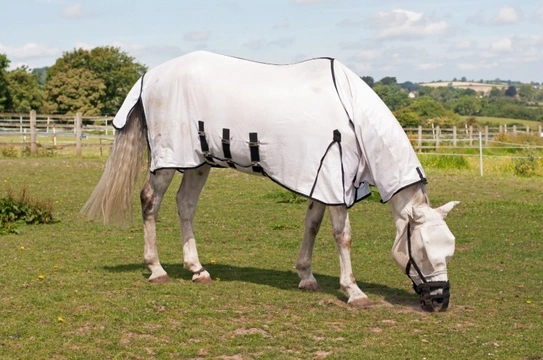
The Flies Are Coming!
A late spring has meant a delay to the usual insect life but, following a very wet spell, the recent warm weather has given a real kickstart to the fly season. So, how can you protect your horse from the misery of biting insects?
Horses vary in the amount of fly protection they need based on their breed or type and the set up of their grazing areas.
Fly masks
Some horses tolerate flies very well whereas others are driven to distraction and can risk injuring themselves trying to scratch bites or avoid the insects. Even if your horse tolerates flies well, you should always protect their eyes with a fly mask as flies will continuously feed on the natural moisture around the eye and can encourage the horse to rub his eyes on his legs; this can lead to conjunctivitis, infection or even cause a foreign body to become lodged in the eye. Eyes should be kept clean and bathed regularly - use a separate wipe for each eye to avoid any cross-contamination.
Fly rugs
Fly rugs will protect almost all parts of the horse from biting insects depending on the style that you choose.
Most fly rugs incorporate a neck piece which may or may not be detachable and a tail flap. Some rugs also have a belly flap to protect the exposed underside of the horse which would be unprotected in a conventional rug design.
Fit is incredibly important as your horse will be wearing this rug for hours at a time. Even with horses out 24/7, fly rugs should always be removed daily to check for any wounds or injuries, trapped insects which can repeatedly bite or sting and any rubbing or chafing. Inevitably, the mesh design or weave can be prone to getting torn particularly with some horses who are more destructive or accident prone and this can form an entry point for insects who then can’t find their way out.
Fly rugs can be very hot so try and choose breathable makes. Zebra print rugs are very fashionable at the moment and owners report far less flies landing on these than the more usual pale coloured rugs. The flies will still approach the horse but the striped pattern seems to confuse them and discourage them from landing.
Other defences against flies
Some horse owners swear by homemade fly sprays; certainly, many of the brands for sale in tack shops don’t seem to do the job and only repel flies for a short period of time. Stronger products which contain Deet may work but some horses react to this chemical and it can adversely affect their skin.
Turning your horse out at night and bringing him at dawn is one way to solve a fly problem. Choosing grazing without trees that is in a more open location will also minimise fly problems but can create other issues like lack of shelter from the sun. Fields with standing water will always attract more flies and mosquitoes.
Fly traps and bug balls
It might seem a hopeless task placing a fly trap in your horse’s field but some of these can be really effective. A fly ball can trap flies which are attracted to the ball and then become trapped on the sticky solution which is sprayed on the surface. A similar design has a fly trap above the ball which the flies go into and then cannot leave. Some people make their own trap by hanging a black bucket upside down and coating it with a sticky glue or even using a simple piece of flat, black plastic.
Sweet itch
Sweet itch is a different problem to fly irritation. Sweet itch is an allergic reaction to the saliva of the biting midge and the itching can drive horses to distraction.
The main form of defence to sweet itch is attack and owners of sweet itch horses are usually well versed in a routine to protect their horse during the warmer months.
There is a fly rug called a Boett blanket which encases the horse and will protect him from biting midges; these are similar in design to a standard fly rug but have a totally dense material which is impenetrable and a different, more snug fit. Sweet itch horses usually live in these rugs and will normally wear them in the stable too.
Sweet itch horses need quite intense, proactive management but many of the techniques that their owners use can be helpful in combating flies and provide some useful insights and tips to other horse owners.
Don’t forget…
Horses with pink noses or pink skin on their legs can need protection from intense sun with sunscreens, either a physical barrier attached to their fly veil or a topical cream or lotion.
Whilst the endless sunshine is lovely, particularly after a wet winter and a cold, late spring, horses do need shelter away from intense heat. This can be provided by a canopy of trees but if there is no natural shade available then you should provide a shelter or bring them in during the hottest part of the day.
Have a handy summer first aid kit. Keep some Chloramphenicol eye drops which are now available from any chemist off prescription, these can treat minor eye irritations like conjunctivitis and infections caused by flies or rubbing. Bites can become infected particularly if the horse has rubbed them so keep a selection of wound sprays and topical barrier creams to protect raw areas from more fly predation. Make sure that the latter are not oil-based as this will cause the horse’s skin to burn in the direct sunlight.



